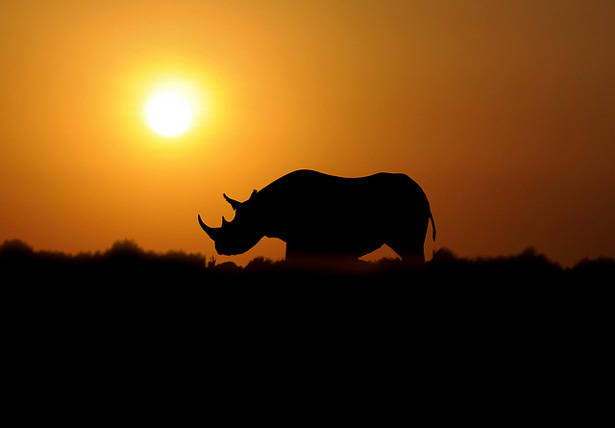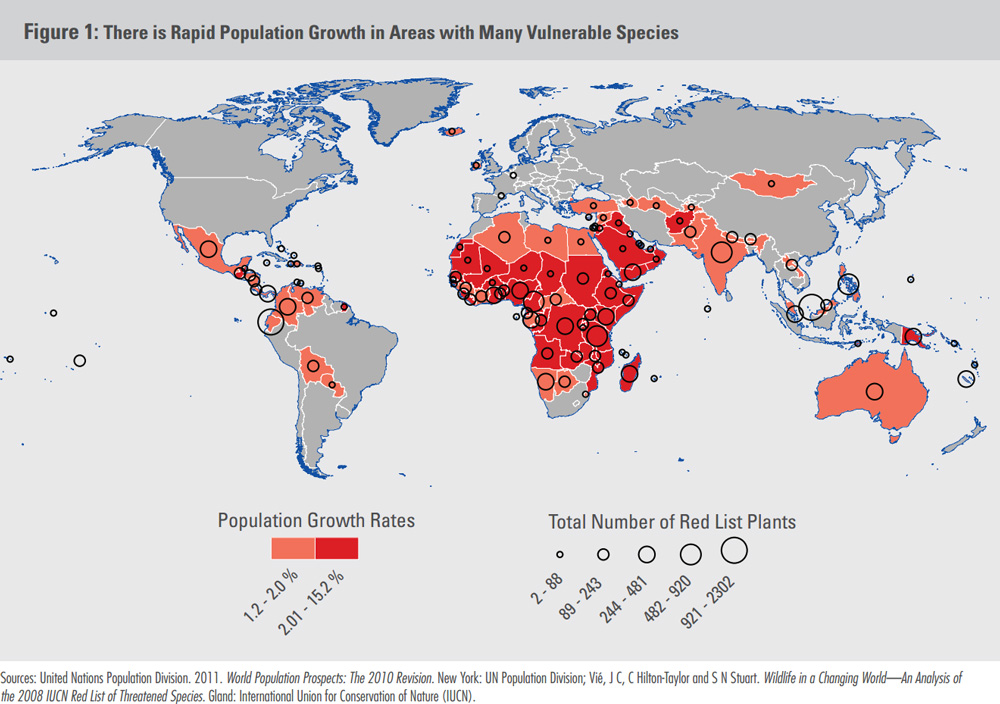-
Crowded Out: New Evidence Points to Population Growth as Key Driver of Biodiversity Loss
November 12, 2013 By Kathleen Mogelgaard
In 2009, economist Jeffrey Sachs, alongside more than 20 eminent scholars from different fields, highlighted the importance of biodiversity for human well-being in a policy commentary published in Science. They noted the Millennium Development Goals (MDGs) included a target to achieve, by 2010, a significant reduction in the rate of species loss, and they also noted that it was one of the MDG targets that was most off-track. “Our lack of progress toward the 2010 target,” they said, “could undermine achievement of the MDGs and poverty reduction in the long term.” The 2010 target was missed, and today species are moving toward extinction at an ever faster pace. Last week’s announcement confirming the extinction of Africa’s western black rhino is the latest sad example of this trend.
A Critical Foundation of Development
Species extinction rates are an estimated 100 to 1000 times greater than pre-human levels.Biodiversity is valued by society for the multitude of functions it provides: a library of genetic material for pharmaceutical and agricultural development; ecosystem services such as pollination, water purification, and climate regulation; and the moral and spiritual worth associated with other life. The health and sustainability of human society is dependent on these functions, and billions of people, particularly the world’s poorest, rely directly on biodiversity and functioning ecosystems for their survival.
And yet, in this age of man – the “Anthropocene” – biodiversity faces unprecedented threats. Species extinction rates are an estimated 100 to 1000 times greater than pre-human levels, and some biologists have suggested that current extinction rates indicate Earth has entered its sixth mass extinction event. Due to habitat loss, over-exploitation, pollution, invasive species, and climate change, the survival of almost 17,000 plant and animal species is now threatened – and the pressures causing these declines are constant or increasing in intensity.
Drivers of Loss
Paradoxically, the ongoing devastation of biodiversity is occurring alongside a surge in conservation efforts. Since the MDGs were put into place in 2000, the amount of land in parks and preserves globally has actually increased. According to the UN, 14.6 percent of the Earth’s land surface and 9.7 percent of coastal waters are protected. So what is going on?
New research published by Ohio State University anthropologist Jeffrey McKee and his colleagues in Human Ecology may provide part of the answer. Their work suggests that it is the growth in human numbers – even more than economic growth and land-use changes – that drives species decline.
Research to date has generally shown a strong correlation between the relative number of threatened species and human population growth and density. Mapping work by Population Action International, for instance, overlays national population growth rates with national data on threatened plant species, and even from a simple visual inspection, clear patterns linking higher population growth rates with greater numbers of threatened species are evident (see Figure 1).
McKee’s study, however, goes beyond correlation to offer evidence that increasing population density – that is, population growth – is actually a key ultimate cause of species decline. In an earlier study, McKee and colleagues used the International Union for the Conservation of Nature’s “Red List” and population data from 2000 to develop a multiple regression model to explain threats to species. The model showed that human factors such as GDP and agricultural land use were important contributors, but that the strongest human factor connected to extinction threats was population density. The new study tests the validity of the initial model by applying it retroactively to population growth and threatened species trends from 2000 to 2010. The model holds up, showing that growth in population density was a strong predictor of extinction threat.
As a statistical model, McKee’s study can’t explain exactly why population density has such a strong effect on species loss, only that it does. McKee and his colleagues recognize that a multitude of mediating factors directly and indirectly affect the availability of resources that species need to survive, but their work demonstrates that human population density is at the core of the threats facing biodiversity.
Climate Change Likely to Further Exacerbate Extinctions
McKee and his colleagues used population projections to model the extent of extinction threat in the future, finding that the average nation with a growing population can expect a 3.3 percent increase in the number of threatened mammals and birds over the next decade, and a 10.8 percent increase by 2050, based on human population growth alone. And we know that future population growth, according to recent UN projections, is likely to be substantial: the medium projection shows growth from 7.2 billion today to 9.6 billion by 2050, with continued growth through the end of the century.
McKee is quick to point out though that his research did not include emerging threats to species. “These projected losses for biodiversity will occur from population growth alone, not taking into account factors of climate change, which will exacerbate the extinction problem,” he told participants of a recent webinar in which he shared a summary of the research.
And indeed, another recent study indicates significant ecosystem threat from climate change. Dieter Gerten of Potsdam Institute for Climate Impact Research and his colleagues found that under a 2-degree Celsius warming scenario, substantial habitat changes – such as changes to water flows and vegetation composition – are likely to occur, affecting 11 percent of the ice-free, unmanaged global land surface and further threatening endemic species. The modeling results for higher warming scenarios, not unlikely given 2 degrees is on the low end of current projections, are even more dire.
Missing From the Post-MDG Development Agenda?
The interlocking relationships between population growth, climate change, and biodiversity loss call for successors to the Millennium Development Goals, which expire in 2015, that recognize such links and frame strategies that are responsive to our connected world.
“Projected losses for biodiversity will occur from population growth alone, not taking into account factors of climate change, which will exacerbate the extinction problem”The goals and targets proposed this summer by UN Secretary-General Ban Ki-moon’s High-Level Panel of Eminent Persons on the Post-2015 Development Agenda provide some constructive initial inputs. Notably, however, they represent a scaling back of attention to biodiversity relative to the initial MDGs. A target under the proposed natural resources goal calls for “safeguarding ecosystems, species, and genetic diversity,” without drawing attention to the urgent need to not only stop rates of species loss, but reverse them – so important when extinction rates are already so high.
The High-Level Panel does focus attention on several critical factors that can affect population growth. The proposed Goal 2 focuses on the empowerment of girls and women, and Goal 4d calls for ensuring universal sexual and reproductive health and rights. Rates of unintended pregnancy remain unacceptably high around the world, and currently 222 million women would like to delay or end childbearing but lack contraception.
Overall, the suggestions of the Secretary-General’s panel are a mixed bag on addressing population-biodiversity dynamics. Ensuring that women are empowered to determine the number, timing, and spacing of their children is an important goal in its own right, and, as this new evidence demonstrates, it could also help halt historically high rates of biodiversity loss. But the lack of urgency elsewhere on reversing biodiversity loss is concerning.
Greater awareness of and attention to these connections can help build momentum for a comprehensive, synergistic development agenda – one that truly optimizes human and environmental well-being.
Kathleen Mogelgaard is a writer and analyst on population and the environment, and a consultant for the Environmental Change and Security Program.
Sources: Biological Conservation, CNN, Conservation International, Convention on Biological Diversity, Futures Group, Guttmacher Institute, Intergovernmental Panel on Climate Change, International Union for the Conservation of Nature, National Geographic, Nature, Ohio State University, Population Action International, Science, UN Population Division, United Nations.
Photo Credit: “Black Rhino Dawn?” courtesy of flickr user Ray Morris; Figure 1, courtesy of Population Action International.
 A Publication of the Stimson Center.
A Publication of the Stimson Center.




